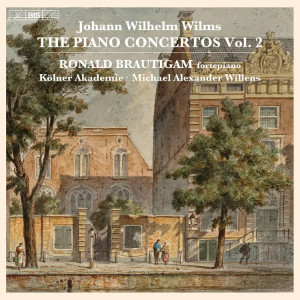
Johann Wilhelm Wilms (1772-1847)
Piano Concerto in F, Op. 32 (1814)
Piano Concerto in E-flat, Op. 55 (1820)
Ronald Brautigam (fortepiano)
Kölner Akademie/Michael Alexander Willens
rec. 2021, Immanuelskirche, Wuppertal, Germany
BIS BIS-2524 SACD [59]
Your reaction to this will depend on your taste for the fortepiano that Ronald Brautigam plays here. At first, its sonority may seem thin, even tinny, but the ear quickly adjusts, and its action – lighter than that of its descendant, the modern concert grand – allows Brautigam to dart through the typical Classical artillery of arpeggios, turns, and runs with plenty of dash. On the downside, the fortepiano doesn’t have the sustaining power to produce a fully weighted legato: it’s locked into a semi-detached articulation, limiting the expressive possibilities. This is particularly felt in the two Adagios, where the soloist’s little decorations read strictly as superficial flourishes; deeper possibilities can’t even be considered.
If you don’t mind the limitations I’ve just described, you’ll be rewarded with two finely wrought examples of big-boned, high-Classical writing. The opening movements, with their lengthy ritornellos presenting both the movement’s themes in full, dominate the scores in their sheer length. The F major’s long exposition was sufficiently emphatic that it veered into the development just as I thought it was ending; conversely, after the final cadences, I found myself expecting one more episode! The E-flat Concerto’s scale is even bigger. Its proclamatory orchestral chords answered by keyboard cadenzas left me wondering whether Wilms might have heard the Emperor. (Wilms, unlike Beethoven, has those chords diminuendo slightly, as if hedging his bets.) So does the hearty 6/8 swing of the closing Rondo.
Even these regular structures leave the composer room for a surprise or two. The dignified sort-of-chorale that starts the F Major doesn’t immediately suggest a sonata-allegro; as horizontal motion builds the textures, it becomes a full-fledged Allegro, all while maintaining the original pulse.
I’ve already suggested Brautigam’s dexterity and agility: in the F Major’s bustling Rondo – undeterred even by a brief detour into the minor – the twinkling Alberti basses practically whiz by. The Kölner Akademie under Willens, playing on period instruments, provide clean playing; it’s the composer’s fault, not the players’, that some tuttis in the E-flat become a bit rowdy-busy. The impeccably tuned woodwinds add a piquant touch to the slow movements, which are forthrightly addressed; this sounds apt, though, as with the keyboard, I could imagine a broader, more ruminative approach.
The sound, even in plain frontal stereo, is excellent. Unless you’re really allergic to the fortepiano, I’d go for this.
Stephen Francis Vasta
stevedisque.wordpress.com/blog
Help us financially by purchasing from




















